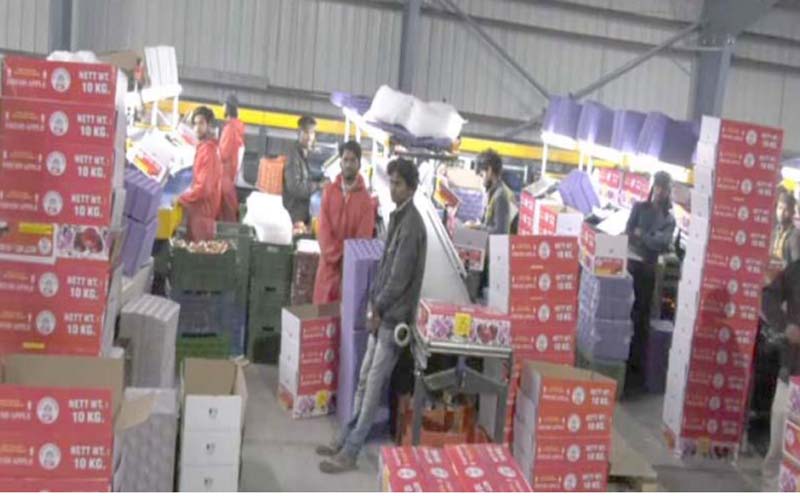 Horticulture
Horticulture Srinagar: Despite the horticulture sector getting a meagre budgetary allocation, the fruit industry continues to be the torch-bearer of Kashmir’s economy by leading in employment generation and export.
As per the official data of Horticulture department, one hectare of an orchard generates almost 400 mandays per year and the wage employment generation per annum is around 8.73 crore mandays.
As per the official details around 7 lakh farming families (approx. 35 lakh souls) are directly or indirectly dependent on Horticulture which contributes about 9 percent to the Jammu and Kashmir’s Gross Domestic Product (GDP).
Over the years, the area under fruit cultivation has increased to 3.31 lakh hectares in 2018-19 and the production of fruits has increased to 24.44 lakh MTs.
According to the official figures, the area under cultivation of fruits in Jammu and Kashmir increased from 2.21 lakh hectares in 2001 to current 3.31 lakh hectares thus registering an increase of 1.1 lakh hectares in two decades.
On one hand the land under agriculture has seen a continuous decline but on the other hand the area under horticulture has seen a huge increase which has cemented the laters position as a torch bearer of the economy.
The figures by the Horticulture Department further reveal that fruit production in the Union Territory (UT) has considerably increased too. In 2001, the fruit production was recorded at 10.9 lakh metric tonnes and the same has now gone up to to 24.44 lakh metric tonnes.
Apple fruit enjoys a lions share in fruit production. In the same period, the production of apples has doubled from 9 lakh metric tonnes to 18 lakh metric tonnes.
The horticultural sector not only sustains the Jammu and Kashmir’s economy but it has also carved a distinct place in the national fruit market too.
In India 77 percent of all apples and 90 percent of all walnuts come from J&K. The UT has been declared as the “Agri Export zone for Apples and Walnuts.”
The other fruit crops grown in the UT are almonds, pears, cherries and apricots in temperate areas and mango, citrus, litchi, papaya, guava etc in subtropical areas. Saffron cultivation in Jammu and Kashmir is already renowned. Globally, Iran ranks first in the production of saffron with its contribution to 70 percent of total production.
India stands at 3rd position and in the country the entire saffron crop comes from J&K. Director Horticulture Kashmir, Aijaz Ahmad said that the horticulture sector has tremendous potential and the department is making efforts to provide the latest techniques to farmers in order to double their income.
Giving details about the department he said during last year around 2 lakh quality plants have been produced and distributed among the farmers. “One Hi-Tech walnut nursery has been established at Zawoora where 20,000 walnut grafted plants are being produced annually.
"The department has also one Advanced Centre at Zawoora Srinagar which serves as a demonstration centre besides providing training to the farmers as well as field staff,” Ahmad said.
He said that a back ended subsidy of Rs 11825.32 lakh has been released in favour of sixteen 16 Controlled Atmosphere (CA) Storage Projects. 13 Fresh CA storage projects have been sent to Govt of India for approval.
“Three lakh Apple clonal rootstocks have been imported. To increase the yield of apples from the present 10-12 MTs to 70 MTs per hectare, the Department has initiated a High Density Plantation Programme. An area of about 193 hectares has already been brought under High Density plantation," he said.
"The department is working out a plan to produce four crore root stocks for covering 10,000 hectare of land under high density plantation. We are planning to convert 100000 hectare area into high density plantation orchards,” he said.
The Director Horticulture said that the Market Intervention Scheme was launched to facilitate the fruit growers with assured support price to mitigate the influence of middleman-ship.
Support Our Journalism
We cannot do without you.. your contribution supports unbiased journalism
IBNS is not driven by any ism- not wokeism, not racism, not skewed secularism, not hyper right-wing or left liberal ideals, nor by any hardline religious beliefs or hyper nationalism. We want to serve you good old objective news, as they are. We do not judge or preach. We let people decide for themselves. We only try to present factual and well-sourced news.







